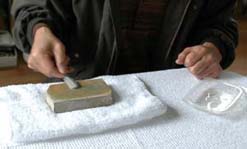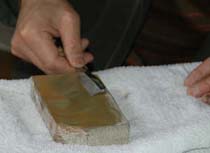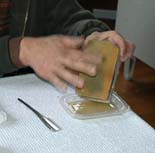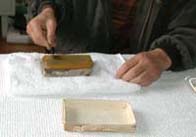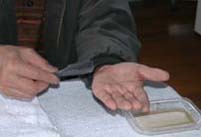- Messages
- 715
All credit to JimR for translation:
Follow-up
Ok folks, here's my translation of the razor honing guide from •ï’šÂÂEƒiƒCƒt‚Ì’Êâ€ÂÌÂÂueÂÂn•¨.comÂÂvƒAƒJƒVƒLƒRƒEÂÂ`ƒlƒbƒ g‚ÌÂÂn•¨‰®‚³‚ñš•ï’šÂÂEƒiƒCƒt‚Ì‚±‚ƂȂ炨‚Ü‚©‚¹ÂÂI. This is NOT my original work, and I have not been able to get written permission for this, so please don't use this for your own nefarious purposes. I'll try to get my translation of the other guide (which claims it's from Ryouchi) up soon. Hope it helps!
方 市原ã•ん直ä¼Âã®カミソリ研ãŽ(下ã®写真ã¯ã€Â市原ã•んã®手ã§ã™(^^))
Initiation into sharpening by Ichihara-san (Those are his hands in the pictures below)
砥石を5~10分ãÂȋ©水ã«浸ã‘ã€ÂÃ¥ÂÂ分水をå«ã¾ãÂ݋¾ã™。
Submerge your stone for 5-10 minutes, until it is well soaked.
研ãÂÂã¨ãÂÂã€Â砥石ã«水を付ã‘る際ã€Â少ã—石ã‘んを混ãœるã¨ã€Âã™ã¹りãŒ良ãÂÂãªりã€Â滑らã‹ã«研ãÂ’ã¾ã™。
When honing, as you add water to your hone, mixing a little soap in the water will improve the slip and make your honing smoother.

剃刀ã®è£Âã€Â先端ã‹ら5mmãÂÂらã„ã®ã¨ã“ã‚Âをã—ã£ã‹り押ã•ãˆã€Â砥石ã«ベタッã¨当ã¦ã¾ã™。
Place the back (ura) of the razor flat on the stone and press firmly at a point about 5mm from the cutting edge.

ãÂÂã®ã¾ã¾ã€Â一定ã®角度をä¿Âã£ã¦砥石ã®全体を使ã†よã†ã«ã€Âスライド。
Maintaining a fixed angle, and making sure to use the whole surface of the hone, slide the razor keeping pressure on the blade.

鎬部分を研ãÂŽã™ãÂŽãªã„よã†ã€Â刃先ã«力を入れã¦ã€Â指ã¨一緒ã«研ãÂÂ感ã˜ã§研ã„ã§下ã•ã„。
To avoid excessive wear on the ridges of the blade, keep pressure focused toward the edge,almost as if you're honing your fingers with the blade.

ã—ã®ãÂŽã®部分ã¨ã€Â刃先ã®部分ãŒ砥石ã«ピタッã¨当ãŸるよã†ã«ã—ã€Â※刃先部分ã«力をã‹ã‘るよã†ã«ã— ã¦研ãÂŽã¾ã™。
Use pressure to make sure the blade ridges and the blade edge stay firmly against the hone.

表ãŒ研ãÂ’ã‚Œã°ã€Â今度ã¯è£Âé¢をベタッã¨当ã¦ã¦軽ãÂÂ研ãÂŽã¾ã™。
表7:è£Â3以下ãÂÂらã„ã§è£Âを研ãÂŽã¾ã™。
For the front (omote), this time hold the backside lightly and hone. Do not exceed a ratio of omote 7: ura 3 when honing the ura.

最後ã€Â手ã®ã²らやジーンズãªã©ã§軽ãÂÂãªã§るよã†ã«ã—ã¦å°Â刃(ã‹ãˆり)をå–りã¾ã™。
Finally, lightly run the razor on your open palm or your jeans to remove the burr or wire edge.

Follow-up
OK, so I apparently TOTALLY screwed up that translation, and only know have the sharp eyes of a couple of our members caught it. I think it's not my fault, because I've never, ever done anything wrong in my entire life. Right?
Anyway, here are the culprits:

剃刀ã®è£Âã€Â先端ã‹ら5mmãÂÂらã„ã®ã¨ã“ã‚Âをã—ã£ã‹り押ã•ãˆã€Â砥石ã«ベタッã¨当ã¦ã¾ã™。
Place the back (ura) of the razor flat on the stone and press firmly at a point about 5mm from the cutting edge.
and
表ãŒ研ãÂ’ã‚Œã°ã€Â今度ã¯è£Âé¢をベタッã¨当ã¦ã¦軽ãÂÂ研ãÂŽã¾ã™。
表7:è£Â3以下ãÂÂらã„ã§è£Âを研ãÂŽã¾ã™。
For the front (omote), this time hold the backside lightly and hone. Do not exceed a ratio of omote 7: ura 3 when honing the ura.
As any fool can plainly see (eventually, after several PMs ), the translated names and the pictures are bass ackwards. The first picture shows what we have all been calling the "Omote" flat against the stone, and the second picture shows the "Ura" against the stone. But the captions say the opposite.
Now, the thing is, the names we've been using ("Ura=stamped" and "Omote=nonstamped") are backed up in several other very reputable sources I've seen, including a response I asked in an email from Ryuichi Mizuochi-san himself. ("Engraved side is the back" is how it was put. Back=ura in Japanese.).
So I'm looking at the first caption, and I can see how I got confused. It says, in Japanese, word for word, "Razor's Ura, at a place 5mm from the leading edge firmly press, on the hone flatly put." So, it could very well be saying press the Ura--meaning PUT YOUR FINGERS ON THE URA.
The second one I just plain screwed up. The verb is "When you have honed the Omote, this time hold the Ura flat (on the stone?) and lightly hone." Bad translation, and thank you guys for catching it.
Eventually.
Sorry about that dudes.
